
Concept explainers
(a)
Interpretation:
The structure is to be drawn, and the correct IUPAC name for the given trivial name is to be provided.
Concept introduction:
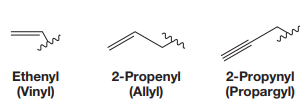
Trivial names such as iso and neo, sec, tert are used to indicate the alkyl groups and their structure as shown below:
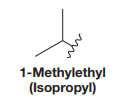
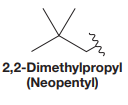
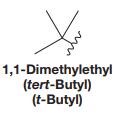
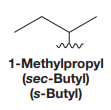
The root names of ketones are derived from those of the parent
Answer to Problem E.23P
The correct IUPAC name for the given trivial name

Explanation of Solution
The name for the given molecule is

The prefix di represents that there are two vinyl groups attached to the carbonyl carbon atom in ketone. Thus, the structure for

While writing the IUPAC name for ketones, the longest continuous carbon chain containing the ketone functional group is to be determined, and it is numbered such that the carbonyl carbon receives the lowest possible numbering. Using this rule, the numbering for the above structure is

The longest continuous carbon chain has five carbon atoms, and the carbonyl carbon is at number 3. Thus, the root name for this will be
The structure of the molecule is drawn and the correct IUPAC name is written for the given trivial name.
(b)
Interpretation:
The structure is to be drawn, and the correct IUPAC name for the given trivial name is to be provided.
Concept introduction:
Ketones consist of two alkyl or aryl groups attached to a carbonyl group, and their trivial names consist of identifying the alkyl or aryl groups and listing them both before the word ketone. Alkyl groups can be alkenes, alkynes, or benzene derivatives. Some of the most common names for alkenes and alkynes are vinyl, allyl, or propargyl. Their structures are as follows:

Trivial names such as iso and neo, sec, tert are used to indicate the alkyl groups and their structure as shown below:




The root names of ketones are derived from those of the parent alkanes, defined by the longest continuous chain of carbon atoms that contains the functional group. For a ketone, drop the -e from the alkane name and add the ending one. To indicate the position of a substituent on a ketone, number the chain in the manner that gives the carbonyl carbon atom the lowest possible locator number. In cyclic ketones, it is understood that the carbonyl carbon atom is C1.
Answer to Problem E.23P
The correct IUPAC name for the given trivial name
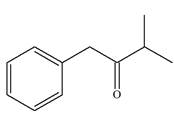
Explanation of Solution
The name for the given molecule is

While writing the IUPAC name for ketones, the longest continuous carbon chain containing the ketone functional group is to be determined, and it is numbered such that the carbonyl carbon receives the lowest possible numbering. Using this rule, the numbering for the above structure is
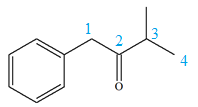
The longest continuous carbon chain has four carbon atoms, and the carbonyl carbon is at number 2. Thus, the root name for this will be
The structure of the molecule is drawn, and the correct IUPAC name is written for the given trivial name.
(c)
Interpretation:
The structure is to be drawn, and the correct IUPAC name for the given trivial name is to be provided.
Concept introduction:
Ketones consist of two alkyl or aryl groups attached to a carbonyl group, and their trivial names consist of identifying the alkyl or aryl groups and listing them both before the word ketone. Alkyl groups can be alkenes, alkynes, or benzene derivatives. Some of the most common names for alkenes and alkynes are vinyl, allyl, or propargyl. Their structures are as follows:

Trivial names such as iso and neo, sec, tert are used to indicate the alkyl groups and their structure as shown below:




The root names of ketones are derived from those of the parent alkanes, defined by the longest continuous chain of carbon atoms that contains the functional group. For a ketone, drop the -e from the alkane name and add the ending one. To indicate the position of a substituent on a ketone, number the chain in the manner that gives the carbonyl carbon atom the lowest possible locator number. In cyclic ketones, it is understood that the carbonyl carbon atom is C1.
Answer to Problem E.23P
The correct IUPAC name for the given trivial name
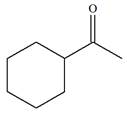
Explanation of Solution
The name for the given molecule is

While writing the IUPAC name for ketones, the longest continuous carbon chain containing the ketone functional group is to be determined, and it is numbered such that the carbonyl carbon receives the lowest possible numbering. Using this rule, the numbering for the above structure is
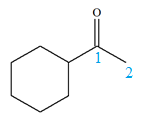
The longest continuous carbon chain has two carbon atoms, and the carbonyl carbon is at number 1. Thus, the root name for this will be
The structure of the molecule is drawn, and the correct IUPAC name is written for the given trivial name.
(d)
Interpretation:
The structure is to be drawn, and the correct IUPAC name for the given trivial name is to be provided.
Concept introduction:
Ketones consist of two alkyl or aryl groups attached to a carbonyl group, and their trivial names consist of identifying the alkyl or aryl groups and listing them both before the word ketone. Alkyl groups can be alkenes, alkynes, or benzene derivatives. Some of the most common names for alkenes and alkynes are vinyl, allyl, or propargyl. Their structures are as follows:

Trivial names such as iso and neo, sec, tert are used to indicate the alkyl groups and their structure as shown below:




The root names of ketones are derived from those of the parent alkanes, defined by the longest continuous chain of carbon atoms that contains the functional group. For a ketone, drop the -e from the alkane name and add the ending one. To indicate the position of a substituent on a ketone, number the chain in the manner that gives the carbonyl carbon atom the lowest possible locator number. In cyclic ketones, it is understood that the carbonyl carbon atom is C1.
Answer to Problem E.23P
The correct IUPAC name for the given trivial name
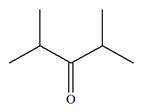
Explanation of Solution
The name for the given molecule is

There is no other substituent present; thus, the structure for the compound is

While writing the IUPAC name for ketones, the longest continuous carbon chain containing the ketone functional group is to be determined, and it is numbered such that the carbonyl carbon receives the lowest possible numbering. Using this rule, the numbering for the above structure is
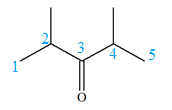
The longest continuous carbon chain has five carbon atoms, and the carbonyl carbon is at number 3. Thus, the root name for this will be
The structure of the molecule is drawn, and the correct IUPAC name is written for the given trivial name.
(e)
Interpretation:
The structure is to be drawn, and the correct IUPAC name for the given trivial name is to be provided.
Concept introduction:
Ketones consist of two alkyl or aryl groups attached to a carbonyl group, and their trivial names consist of identifying the alkyl or aryl groups and listing them both before the word ketone. Alkyl groups can be alkenes, alkynes, or benzene derivatives. Some of the most common names for alkenes and alkynes are vinyl, allyl, or propargyl. Their structures are as follows:

Trivial names such as iso and neo, sec, tert are used to indicate the alkyl groups and their structure as shown below:




The root names of ketones are derived from those of the parent alkanes, defined by the longest continuous chain of carbon atoms that contains the functional group. For a ketone, drop the -e from the alkane name and add the ending one. To indicate the position of a substituent on a ketone, number the chain in the manner that gives the carbonyl carbon atom the lowest possible locator number. In cyclic ketones, it is understood that the carbonyl carbon atom is C1.
Answer to Problem E.23P
The correct IUPAC name for the given trivial name

Explanation of Solution
The name for the given molecule is

There is no other substituent present; thus, the structure for the compound is
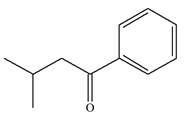
While writing the IUPAC name for ketones, the longest continuous carbon chain containing the ketone functional group is to be determined, and it is numbered such that the carbonyl carbon receives the lowest possible numbering. Using this rule, the numbering for the above structure is
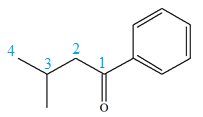
The longest continuous carbon chain has four carbon atoms, and the carbonyl carbon is at number 1. Thus, the root name for this will be
The structure of the molecule is drawn, and the correct IUPAC name is written for the given trivial name.
Want to see more full solutions like this?
Chapter E Solutions
Organic Chemistry: Principles And Mechanisms (second Edition)
- Five isomeric alkenes. A through each undergo catalytic hydrogenation to give 2-methylpentane The IR spectra of these five alkenes have the key absorptions (in cm Compound Compound A –912. (§), 994 (5), 1643 (%), 3077 (1) Compound B 833 (3), 1667 (W), 3050 (weak shoulder on C-Habsorption) Compound C Compound D) –714 (5), 1665 (w), 3010 (m) 885 (3), 1650 (m), 3086 (m) 967 (5), no aharption 1600 to 1700, 3040 (m) Compound K Match each compound to the data presented. Compound A Compound B Compound C Compound D Compoundarrow_forward7. The three sets of replicate results below were accumulated for the analysis of the same sample. Pool these data to obtain the most efficient estimate of the mean analyte content and the standard deviation. Lead content/ppm: Set 1 Set 2 Set 3 1. 9.76 9.87 9.85 2. 9.42 9.64 9.91 3. 9.53 9.71 9.42 9.81 9.49arrow_forwardDraw the Zaitsev product famed when 2,3-dimethylpentan-3-of undergoes an El dehydration. CH₂ E1 OH H₁PO₁ Select Draw Templates More QQQ +H₂Oarrow_forward
- Complete the clean-pushing mechanism for the given ether synthesia from propanol in concentrated sulfurica140°C by adding any mining aloms, bands, charges, nonbonding electron pairs, and curved arrows. Draw hydrogen bonded to cayan, when applicable. ore 11,0 HPC Step 1: Draw curved arrows Step 2: Complete the intend carved Q2Q 56 QQQ Step 3: Complete the intermediate and add curved Step 4: Modify the structures to draw the QQQ QQQarrow_forward6. In an experiment the following replicate set of volume measurements (cm3) was recorded: (25.35, 25.80, 25.28, 25.50, 25.45, 25.43) A. Calculate the mean of the raw data. B. Using the rejection quotient (Q-test) reject any questionable results. C. Recalculate the mean and compare it with the value obtained in 2(a).arrow_forwardA student proposes the transformation below in one step of an organic synthesis. There may be one or more reactants missing from the left-hand side, but there are no products missing from the right-hand side. There may also be catalysts, small inorganic reagents, and other important reaction conditions missing from the arrow. • Is the student's transformation possible? If not, check the box under the drawing area. • If the student's transformation is possible, then complete the reaction by adding any missing reactants to the left-hand side, and adding required catalysts, inorganic reagents, or other important reaction conditions above and below the arrow. • You do not need to balance the reaction, but be sure every important organic reactant or product is shown. + T G OH де OH This transformation can't be done in one step.arrow_forward
- Macmillan Leaming Draw the major organic product of the reaction. 1. CH3CH2MgBr 2. H+ - G Select Draw Templates More H о QQarrow_forwardDraw the condensed structure of 3-hydroxy-2-butanone. Click anywhere to draw the first atom of your structure.arrow_forwardGive the expected major product of reaction of 2,2-dimethylcyclopropane with each of the following reagents. 2. Reaction with dilute H₂SO, in methanol. Select Draw Templates More CHC Erase QQQ c. Reaction with dilute aqueous HBr. Select Drew Templates More Era c QQQ b. Reaction with NaOCH, in methanol. Select Draw Templates More d. Reaction with concentrated HBr. Select Draw Templates More En a QQQ e. Reaction with CH, Mg1, then H*, H₂O 1. Reaction with CH,Li, then H', H₂Oarrow_forward
- Write the systematic name of each organic molecule: structure O OH OH name X ☐arrow_forwardMacmillan Learning One of the molecules shown can be made using the Williamson ether synthesis. Identify the ether and draw the starting materials. А со C Strategy: Review the reagents, mechanism and steps of the Williamson ether synthesis. Determine which of the molecules can be made using the steps. Then analyze the two possible disconnection strategies and deduce the starting materials. Identify the superior route. Step 6: Put it all together. Complete the two-step synthesis by selecting the reagents and starting materials. C 1. 2. Answer Bank NaH NaOH NaOCH, снен, сен, он Сиси, Сне (СН), СОН (Сн, Свarrow_forwardWrite the systematic name of each organic molecule: structure CH3 O CH3-CH-CH-C-CH3 OH HV. CH3-C-CH-CH2-CH3 OH CH3 O HO—CH, CH–CH—C CH3 OH 오-오 name X G ☐arrow_forward
 Chemistry for Today: General, Organic, and Bioche...ChemistryISBN:9781305960060Author:Spencer L. Seager, Michael R. Slabaugh, Maren S. HansenPublisher:Cengage Learning
Chemistry for Today: General, Organic, and Bioche...ChemistryISBN:9781305960060Author:Spencer L. Seager, Michael R. Slabaugh, Maren S. HansenPublisher:Cengage Learning Organic Chemistry: A Guided InquiryChemistryISBN:9780618974122Author:Andrei StraumanisPublisher:Cengage Learning
Organic Chemistry: A Guided InquiryChemistryISBN:9780618974122Author:Andrei StraumanisPublisher:Cengage Learning Organic And Biological ChemistryChemistryISBN:9781305081079Author:STOKER, H. Stephen (howard Stephen)Publisher:Cengage Learning,
Organic And Biological ChemistryChemistryISBN:9781305081079Author:STOKER, H. Stephen (howard Stephen)Publisher:Cengage Learning, General, Organic, and Biological ChemistryChemistryISBN:9781285853918Author:H. Stephen StokerPublisher:Cengage LearningChemistry: Matter and ChangeChemistryISBN:9780078746376Author:Dinah Zike, Laurel Dingrando, Nicholas Hainen, Cheryl WistromPublisher:Glencoe/McGraw-Hill School Pub Co
General, Organic, and Biological ChemistryChemistryISBN:9781285853918Author:H. Stephen StokerPublisher:Cengage LearningChemistry: Matter and ChangeChemistryISBN:9780078746376Author:Dinah Zike, Laurel Dingrando, Nicholas Hainen, Cheryl WistromPublisher:Glencoe/McGraw-Hill School Pub Co Chemistry: Principles and PracticeChemistryISBN:9780534420123Author:Daniel L. Reger, Scott R. Goode, David W. Ball, Edward MercerPublisher:Cengage Learning
Chemistry: Principles and PracticeChemistryISBN:9780534420123Author:Daniel L. Reger, Scott R. Goode, David W. Ball, Edward MercerPublisher:Cengage Learning





